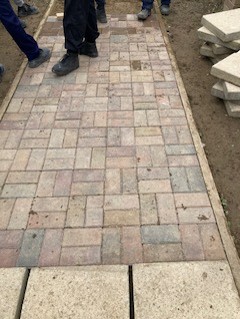Block Paving

Laying block paving involves creating a durable and visually appealing surface using interlocking blocks. The process begins with preparing the area by excavating to the required depth and ensuring a stable, compacted base. A layer of sharp sand is then spread evenly over the compacted base to create a bedding layer.
 Next, the blocks are laid in the desired pattern, such as herringbone or stretcher bond, starting from a fixed edge or corner. Each block is carefully placed and tapped into position using a rubber mallet to ensure they are level and aligned correctly. Edging restraints, such as concrete or metal, are installed to secure the perimeter and maintain the shape of the paving.
Next, the blocks are laid in the desired pattern, such as herringbone or stretcher bond, starting from a fixed edge or corner. Each block is carefully placed and tapped into position using a rubber mallet to ensure they are level and aligned correctly. Edging restraints, such as concrete or metal, are installed to secure the perimeter and maintain the shape of the paving.
Once all blocks are laid, jointing sand is swept over the surface, filling the gaps between the blocks. Excess sand is brushed off, and the area is compacted again to settle the blocks and lock the sand into place. A final sweep of jointing sand may be applied to achieve a seamless finish.
Laying block paving requires attention to detail and proper technique to create a smooth and durable surface suitable for driveways, pathways, or patios. It's a popular choice due to its versatility, aesthetic appeal, and ease of maintenance once properly installed.


